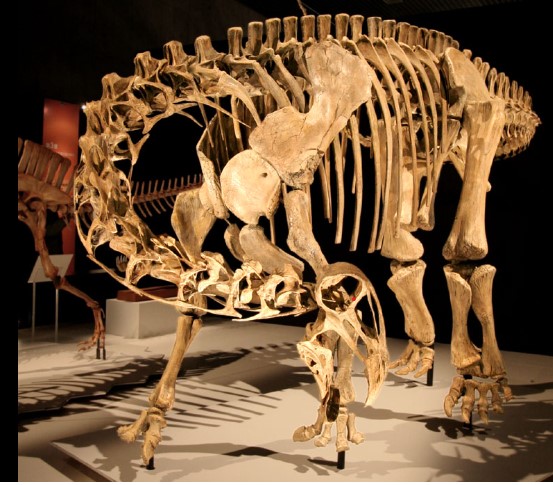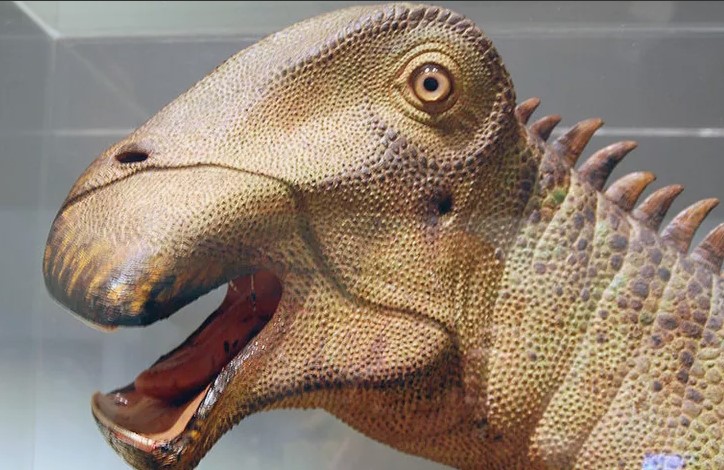It is a plant eating dinosaur
Actual name
Nigersaurus, pronounced NYE-jer-SORE-us (Greek for “Niger lizard”).
Habitat
African woodlands serve as their habitat.
Historical Period
Early Cretaceous period of history (110 million years ago)
Weight
The largest species, according to experts, may have been around (33.5 metres) long. However, in other areas of the fossil record, sauropods measuring 40 to 85 feet (12 to 26 metres) are widespread.
Diet
Plant-based diet
Discremenate Features
Numerous teeth in wide jaws and a somewhat short neck are distinguishing features.

How it discovered?
It was found in the State of Niger’s Gadoufaoua region of the Elrhaz Formation. This dinosaur’s fossils were first documented around 1976, but it wasn’t until 1999—after more and better-preserved bones had been discovered and described—that it was given its scientific name, Nigersaurus taqueti. The specific name honours paleoanthropologist Philippe Taquet, who found the first remains, while the generic name is “Niger reptile.”
{ It’s been an amazing first week out there! Every dune seems to hold a remarkable discovery for us. We discovered the remains of the lengthy dinosaur Nigersaurus on the first day. You may recall that we gave the bones from the most recent trip here, which took place three years ago, the name Nigersaurus. The unique skull of this long-necked dinosaur contains up to 500 thin teeth. Finding the remains of this rare dinosaur will enable us to characterise it and reassemble it for public viewing, which is one of the main objectives of this mission.
We found a skeleton several days later, so we are rapidly approaching that objective! The tail of this skeleton is curled upward as it lies on its side. The length of the backbone’s bend is approximately 15 feet. We created tunnels between the main parts of the skeleton and gently brushed the sand from the 110 million-year-old bones. In order to move the skeleton from the field back to the lab, we will soon plaster over every place. But Nigersaurus is more than just that. Chris led the group to a flat stretch of magenta granite where he had discovered a young Nigersaurus’ upper jaw, which was small enough to fit on upper edge of a silver dollar. This Nigersaurus hatchling had probably just been alive for a few months before it perished and became petrified.

Classification
Originally identified as a dicraeosaurid in 1976, the remnants of Nigersaurus were reclassified by Sereno’s team in 1999. The subfamily Diplodocoidea, which also includes the lengthy diplodocids and the shallow dicraeosaurids, has a family called Rebbachisauridae as its basalmost member. John A. Whitlock defined the subfamily Nigersaurinae in 2011. This subfamily includes the genus Nigersaurus and strongly linked genera.
Structure of skeleton and arrangement of muscles
- The sauropod was able to gather a lot of food and cultivate it within one metre (3 feet 3 inches) of the ground thanks to the width of its muzzle and the lateral position of its tooth row. This is further corroborated by the presence of facets on the labial (outward-facing) of the upper teeth, which are also present in Dicraeosaurus and Diplodocus. These facets are proof that the animal’s teeth were worn down by the food or substrate as it fed. The inside of the maxillary crowning of Nigersaurus also show evidence of low-angle tooth-to-tooth wear, which shows that the dinosaur’s jaw movement was restricted to exact up-and-down motions. Although lower jaw worn teeth have not yet been found, they are anticipated to have opposing tooth-to-tooth wear.
- The jaw’s adductor muscle seems to have joined the quadrate rather than the supratemporal fenestra. It is believed that Nigersaurus was one of the poorest bites since the chewing and swallowing muscles were probably feeble. The tooth pits and scratches created by grit (which would not be acquired as commonly by high-browers and are small, virtually parallel in nature) suggest that it ate slightly softer, herbaceous plants like low-growing ferns, according to Whitlock in 2011. It probably couldn’t have chewed due to the lateral placement of the teeth. The tooth replacement rate of Nigersaurus was the highest of any documented dinosaur, and it wore its tooth tops down more quickly than other herbivorous dinosaurs.
Overall note
The 30-foot-long Nigersaurus was a plant-eating dinosaur that existed 110 million years ago in the Sahara Desert of present-day Niger. Along with the predator dinosaur Suchomimus, the plant – eating the supercroc, Nigersaurus thrived in a lush environment. Nigersaurus had a fragile skull and a mouth that was incredibly broad, lined with teeth made especially for ground-level plant browsing. The extraordinarily large, straight-edged muzzle of this strange, long-necked dinosaur, which is crowned with more than 500 interchangeable teeth, is one of its most distinctive features. One of the first dinosaur skulls to be digitally recreated from CT scans is the genuine fossil skull of Nigersaurus.